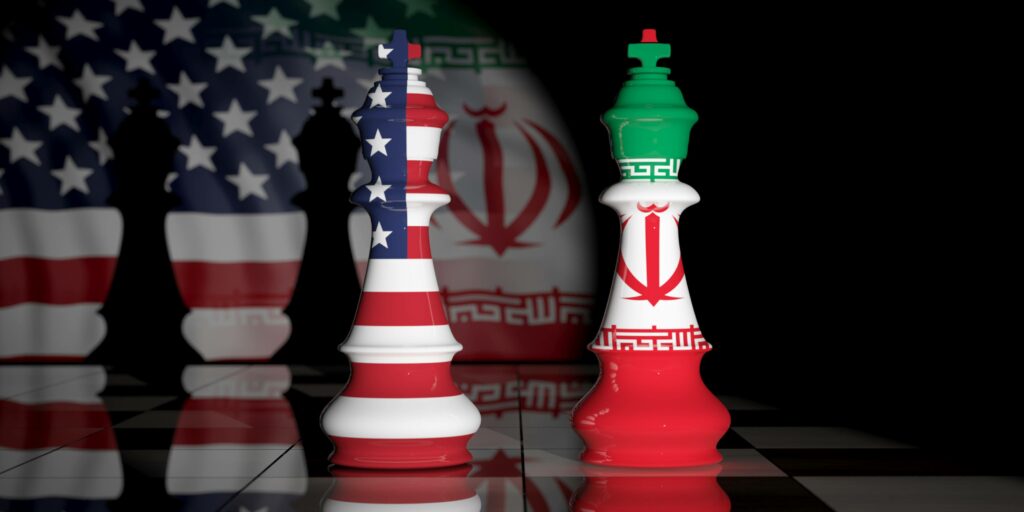- +352 444 222
- Monday-Friday 12:00-18:00
- 20, avenue Marie-Thérèse, 2132 Luxembourg


Introduced in 1979 following the break-up between the United States and the young Islamic republic, sanctions now affect many sectors of the Iranian economy. The hostage-taking of American embassy staff in Tehran by supporters of Ayatollah Khomeini has profoundly altered the privileged relationship that the United States once enjoyed with the Iran of Shah Mohammad Reza Pahlavi.
The two states have been locked in a logic of ideological confrontation since the revolution of 1979, and more particularly since the early 2000s, when George W. Bush included the Islamic Republic in an “axis of evil” following the attacks of September 11, 2001. Iran’s conservative president at the time, Mahmoud Ahmadinejad, elected in 2005 and re-elected in 2009, fuelled this opposition by using a hawkish rhetoric and referring to the nuclear program in a more outspoken way.
This historic rift between the United States and Iran is deeply rooted in regional geopolitics. Since its inception, the Islamic Republic has sworn to destroy the State of Israel, which it considers illegitimate and the primary intermediary of US policy in the Middle East.
This confrontation led to the introduction of increasingly severe economic sanctions against Iran: a freeze on financial assets as early as 1980, an arms embargo in 1984 during the Iran-Iraq war, and then an embargo on oil in 1995, the country’s main source of revenue. In 2004, the ban on all scientific cooperation was designed to hinder Iran’s nuclear program, which was accused of secretly having a military component, in violation of the Nuclear Non-Proliferation Treaty (NPT). Iran has been a signatory to the NPT since 1968, and is part of a system of international cooperation based around the American Atom for Peace program. Tehran wanted to benefit from the sharing of knowledge and technology promised by the Treaty, under the aegis of the International Atomic Energy Agency (IAEA).
The US policy of containment pursued since 1994 led to the implementation of acomprehensive sanctions regime between 2012 and 2015, causing Iran’s GDP to fall by 32% and the Iranian riyal to devalue dramatically against the dollar. The embargoes are aimed primarily at Iran’s financial system, which is excluded from the international SWIFT system, and at hydrocarbon exports, on which the local economy is largely dependent. The country holds the world’s second-largest gas reserves, and the fourth-largest oil reserves. Its exports are mainly directed to Asian countries such as South Korea and China, now the world’s largest importer of crude oil and second largest consumer after the United States. Oil revenues will account for 35% of Iranian state revenues in 2019, but forty years of US sanctions have profoundly altered the country’s refining capacity and overland transport network. In 2017, despite its vast resources, Iran imported an average of 13 million liters of gasoline every day.
These sanctions, among the toughest in the world, have gradually highlighted the structural weaknesses of the Iranian economic system. The growing budget deficit, which is not offset by tax revenues, and colossal inflation (40% by 2020) have led to a flourishing of informal economic sectors (smuggling, black market currency, trafficking, etc.) and, more generally, a deterioration in the business climate. In recent years, the unpredictability of the Iranian economy has led to a sharp decline in foreign direct investment and confidence in partnerships with local companies.
In 2009, Ayatollah and Supreme Guide Ali Khamenei, who has been in power in Iran since June 1989, promoted the concept of an “economy of resistance”(eghtesad-e moqawamat) based on self-sufficiency and domestic production to counter Western sanctions. This state doctrine, comparable to the war economy or resilience, and supported by the Revolutionary Guards (the regime’s ideological army), is not a solution to the challenges facing Iran.
This economic impasse, essentially imposed by Washington, is motivated by the US policy of regime change. The aim of the embargoes was to reduce Iran’s capacity to develop nuclear weapons, but also to provoke an uprising of the local population against the regime. From this point of view, sanctions are more a lever of domestic policy than a simple tool of economic diplomacy.
After lengthy negotiations, a compromise was finally reached in the UN Security Council, enabling the signing of the Vienna Agreement, or Joint Comprehensive Plan of Action (JCPOA), on July 14, 2015. This agreement between the 5 permanent members of the Security Council, Germany and Iran provided for a gradual lifting of sanctions on Iran in exchange for Iranian guarantees that its nuclear program would be limited to civilian use, under IAEA supervision. It is also the fruit of intense negotiations between the governments of Barack Obama and the reformist Iranian president Hassan Rohani. However, the election of Donald Trump in 2016 dashed this timid hope of openness, with the unilateral withdrawal of the United States from the agreement in 2017.
By imposing new sanctions on Iran, the new American president dangerously accentuated the opposition between Washington and Teheran. Donald Trump’s administration accused Iran of failing to comply with the 2015 agreement, despite multiple IAEA reports, contradicting official US rhetoric. This renewed tension between the two countries is also fuelled by Iran’s regional policy.
Tehran has in fact been inserting itself into the Syrian, Iraqi and Yemeni civil wars since 2014 through financial and military support for groups opposed to an American presence in the Middle East. Thus, through militias loyal to it and the pasadran (Revolutionary Guards), Iranian influence has grown considerably in Iraq and Syria, where Iran has taken part in the fighting against the Islamic State. Moreover, Iran’s involvement in regional security issues is part of a political and ideological rivalry between Tehran and its Gulf neighbors, who enjoy almost unconditional support from Donald Trump, particularly Saudi Arabia. Designed to contain these activities, which are deemed destabilizing for the region, the US sanctions also target the Revolutionary Guards as a terrorist organization, and all state or private entities considered to be ideological or financial supporters of the regime.
In parallel with this escalation of tensions, Iran has gradually backed away from its commitments to its nuclear program, and will restart uranium enrichment in 2019. The Iranian objective is to put pressure on the other members of the agreement to bring Washington back on board and respect their promise to open up the country’s economy.
However, the sanctions regime that has been suffocating Iran for several years has met with mixed approval from international players, including Washington’s historic allies. Unfavorable to the new American orientation towards the Tehran regime, France, Germany and the UK set up the INSTEX barter system in January 2019. The aim was to circumvent the Trump administration’s new sanctions and the resulting ban on trade with the Islamic Republic by avoiding the use of the dollar. However, the value of this mechanism is severely limited by the exclusion of oil from trade, and its reduction to exports of foodstuffs and medicines, products theoretically excluded from US embargoes.
In addition, the US withdrawal from the JCPOA and the inability of European states to circumvent embargoes has not been without impact on Iranian domestic policy. Indeed, it has fueled the rhetoric of conservatives opposed to the agreement, accusing reformers in favor of opening the country’s economy to the West of naiveté. All in all, Iran’s confidence in the European Union and the United States has been deeply damaged, and this partly explains the difficulty of the current negotiations.
Nevertheless, the election of Joe Biden in January 2021 was a major turning point in relations between the United States and Iran. The new Democratic president clashes with his predecessor on a number of points, particularly with regard to Middle Eastern issues. A supporter of the 2015 agreement, Biden relaunched talks between the United States and Iran at the start of his term. However, given Teheran’s refusal to talk directly with the United States, the European countries that were members of the old agreement (France, the United Kingdom and Germany) acted as intermediaries between the Iranian and American delegations. Moreover, the end of Hassan Rohani’s term of office in June 2021 and the election of conservative President Ebrahim Raissi have also slowed down these discussions, despite the urgency of preventing the development of an Iranian atomic weapon.
Despite recent progress in indirect negotiations between Iran and the United States, a number of sticking points remain, particularly in relation to Tehran’s regional policy. Pillars of US policy in the region, Israel and Saudi Arabia have officially stated their opposition to a new agreement with Iran, given the new geostrategic context. These two countries, which are in direct confrontation with the Islamic Republic, are demanding guarantees regarding Iran’s ballistic missile program and the use of proxies in neighboring countries.
In response to what it considers to be an existential threat, the Hebrew state has regularly stated its intention to take all necessary measures to prevent Iran from acquiring a nuclear bomb, including by military means. Several actions designed to hinder Iran’s nuclear program have been blamed on Israel, such as the assassination of nuclear physicist Mohsen Fakhrizadeh in November 2020, or the cyberattack targeting the Natanz facility in April 2021. Saudi Arabia, on the other hand, regularly threatened in the south by Yemen’s Houthi rebels and in the north by Iraqi militias, has been forced to enter into talks with Iran in September 2021, via the Iraqi government.
It is therefore necessary to take account of regional strategic developments to understand the stakes involved in the Iranian nuclear negotiations. The Tehran regime has also taken steps to raise the stakes and strengthen its position in discussions with the West. For example, several maritime incidents have been attributed to Iran in the Persian Gulf, through which 30% of the world’s hydrocarbons pass. We can also mention the arrest of foreigners or dual nationals in Iran, such as the Franco-Iranian researcher Fariba Adelkah and the French tourist Benjamin Briere, whose imprisonment no doubt serves as diplomatic leverage for Iran.
Despite the new Iranian government’s distrust of Washington and the Europeans, Iran is facing the most serious economic crisis in its history. U.S. sanctions have stifled the local economy, and are now having an impact on all the country’s imports, particularly of medicines and medical equipment. This is why, despite its tough stance towards the West, Ebrahim Raissi’s conservative government is forced to reach an agreement and lift sanctions. However, since the eight sessions of talks in Vienna, Iran and the United States have been passing the buck. Iran would like to obtain a guarantee from the United States that future US administrations will respect the agreement, so as not to repeat the Trump scenario.
On February 4, 2022, by granting a nuclear-related sanctions waiver, the United States sent a positive sign to the Iranians: this measure authorizes Western companies to enter into civil nuclear partnerships with Iran. However, the Tehran government would like to see more actions linked to the local economy. Since the start of the negotiations, Iran has been demanding the release of funds from abroad, in particular from South Korea. As a result of US sanctions, over $7 billion in Iranian funds are frozen in two South Korean banks: the Industrial Bank of Korea (IBK) and Woori Bank.
With mixed results from his first year in office, Joe Biden seems determined to reach an agreement with Iran. However, this recent progress in the negotiations has raised questions among American politicians, both Democrats and Republicans. Democratic Senator Bob Menendez has come out against a new agreement with Iran, believing that the restrictions imposed on the Islamic Republic remain insufficient. Arguments against a new agreement point in particular to the absence of guarantees concerning Iran’s ballistic missile program and its support for militias devoted to it in the region. On February 8, 2022, 33 Republican senators penned a letter to the Biden administration, calling on the president to bring the new agreement to a vote in Congress as a treaty. The latter would then require two-thirds ratification by the Senate, where the Democrats hold a very slim majority. Senate Republican Leader Mitch McConnell also cited Menendez’s report in urging the Biden administration to exert more pressure on “the greatest threat to the United States and its partners”.
The sanctions regime imposed on Iran has not, however, brought about any change in Iran’s attitude towards its nuclear program, let alone its activities to influence the region. On the contrary, Iran now enriches uranium to the tune of 60% (90% is needed to make a bomb) and has strengthened its grip on the Middle East in parallel with its military operations in Iraq and Syria. From a strategic point of view, sanctions have also prompted Iran to develop partnerships with authoritarian regimes and adversaries of the United States, led by China and Russia. Of the eight countries that have obtained a waiver from the United States to import Iranian oil, China remains the only one that can continue to stand up to Washington. Beijing has set up a barter system to import Iranian raw materials and export consumer goods to Iran, avoiding dollar transactions.
Even more symbolically, Beijing and Tehran signed a strategic cooperation pact on March 27, 2021, promoting partnerships in both the economic and military fields. In addition, we must consider Iran’s entry into the Shanghai Cooperation Organization (SCO), within which China intends to capitalize on its far-reaching commercial ambitions. As the gap between the West and Iran has widened in recent years, China has stepped up its commercial presence in Iran, particularly in the tourism and infrastructure sectors, which are essential to China’s New Silk Roads project.
In the event of a new agreement and the lifting of sanctions, it will be necessary to take into account the new business networks involving China, as well as the consequences for the regional economic landscape. Indeed, opening up Iran to the international market would strengthen economic competition between the Islamic republic and its Gulf rivals. The country’s decades-long isolation from the rest of the world has helped to focus interest on the oil monarchies and their spectacular growth in recent years.
In addition, Iran is one of the Middle East’s top destinations for young graduates, particularly in the fields of engineering, industry and medicine. Iran’s well-educated youth (50% of Iranians are under the age of 30) are also generally very Western-oriented and aspire to an international economic opening. The country offers major potential in a number of sectors. Its vast energy resources had notably attracted Total’s interest in July 2017 in developing the South Pars gas field. Although the State is omnipresent in the automotive sector, the latter is also of major interest given the degree of competitiveness of Iranian manufacturers in the region, in particular IDRO(Industrial Development and Renovation Organization of Iran) and Iran Khodro, in conjunction with Peugeot.
It is therefore essential to take into account the historical context in order to understand the sanctions regime applied to Iran over the last few years. Geopolitical tensions between Iran, its Gulf neighbors and Israel, Washington’s historic allies, are also central to negotiations between the Islamic Republic and the United States. Iran’s ballistic missile program and Tehran’s influence in the region remain points of contention hampering talks in Vienna. However, the latest progress holds out the prospect of a new agreement on the Iranian nuclear issue, but does not resolve all the problems linked to Iran’s place in the region. Indeed, the establishment of a resistance economy by the Iranian government has also strengthened its presence within the country’s major corporations through entities linked to the Revolutionary Guards, considered terrorists by several Western countries. For several years now, the Pasdaran have been playing a central role in Iranian companies of strategic interest to the country.
If the economy opens up, many Western and Asian companies will set up partnerships with Iran, which has great potential in the industrial, medical and tourism sectors. However, it is necessary to take into account the position of Iran’s partners in its economy, namely Russia and China. Companies wishing to develop their business in Iran must therefore increase their knowledge of the country and of target companies likely to have links with the pasdaran or affiliated entities.
SIMON GIRARD
Consultant, Middle East Department, ADIT
Dear users, on 15/06/2022 Internet Explorer will be retiring. To avoid any malfunctioning, we invite you to install another browser, such as Google Chrome, by clicking here, or the one of your choice.
Please check this before contacting us in the event of a problem.
